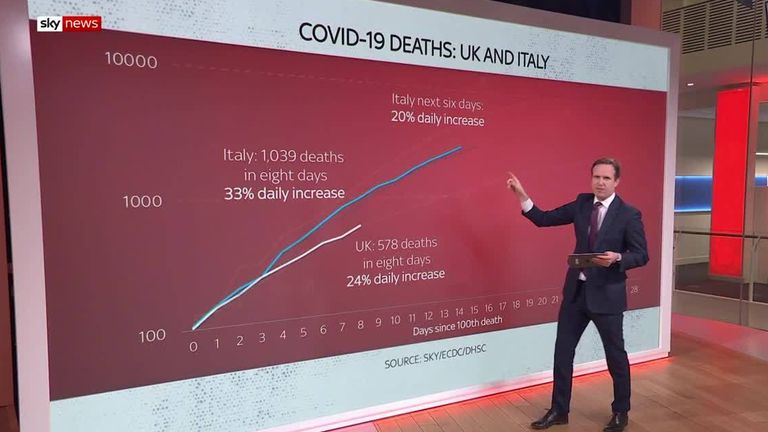Coronavirus daily update: The COVID-19 numbers and what they really mean
As cases and deaths continue to rise across the country, Sky News looks at the data to see what can be learnt.
Tuesday 4 August 2020 11:12, UK
You can tell the government is anxious when the prime minister gets out of his self-isolation bunker, looking pretty rough, to record a video message reassuring the nation.
Some people might know that the number of coronavirus deaths will rise exponentially until the lockdown measures have time to work but that doesn't mean they aren't shocked and worried when it happens.
Sky News has taken a deep dive into the COVID-19 figures, to see what's really happening.
UK deaths
563 people were added to the total of those who have died in the UK with COVID-19 - now 2,352.
It was just a 31% increase on the previous day's rise but a full 383 people more than on Monday.
86% of deaths reported on Wednesday (486) took place in England where the NHS says 2,137 people have now died but Wales recorded by far its biggest increase in deaths since the outbreak began - 29, more than twice its previous record daily total of 14 which it reported on Monday.
98 people in Wales have now died with COVID-19 and we can expect it to pass the 100 mark today. Scotland also reported a record increase - 16 deaths - to take its total to 76, and Northern Ireland added two deaths to take its tally to 30.
The Department of Health and Social Care (DHSC) compiles the death figures from data supplied by the health agencies of the four nations (NHS England, Health Protection Scotland, Public Health Wales and Public Health Agency NI).
The data has to be validated, and each nation works to a slightly different timescale, so the UK figure released by the DHSC does not always match the sum of the published national figures.
This was again the case on Wednesday with the government reporting 11 more deaths in its figures than the nations themselves. The Public Health England (PHE) dashboard is reporting 29 more deaths in England (2,166) than in the NHS figures on Wednesday and it still has Scotland on 60 deaths and Northern Ireland on 28, instead of 76 and 30 respectively.
We can expect those 29 extra deaths in England and the missing deaths in Northern Ireland and Scotland to appear in today's figures.
London still accounts for a third of deaths in England with 706 in total with the West Midlands (299) and the south East (280) both expected to pass 300 deaths on Thursday.
Only the North East is still in double figures (64 deaths). London with 6.4 deaths per 100,000 people and the West Midlands with 4.1 deaths per 100,000 people are the only regions above the UK average of 2.7 on this measure.
Within Wednesday's death figures for London was the 13-year-old boy who died on Monday at King's College Hospital Trust. That trust reported 19 new deaths on Wednesday but two others in London (Hillingdon and London North West Healthcare) reported 20 deaths each.
Two of those 40 deaths happened before 21 March but 38 of them happened between Friday and Tuesday. In total 138 deaths in London were included in NHS England's figures on Wednesday, another new record.
The last two days have also seen a number of Trusts enter the list for the first time, including County Durham & Darlington NHS Trust (4 deaths) and Dartford & Gravesham which reported 3 deaths - all from 22nd March.
All the patients who died in England were aged between 13 and 99 - 20 of them had no known underlying health conditions, including the 13-year-old.
UK cases
On 1 March, the UK reported 12 confirmed cases of COVID-19, one month later it reported 4,324 confirmed cases and a total of 29,474.
It is likely to pass 30,000 confirmed cases on Thursday.
Wednesday's increase in cases ended a run of four days with flatter growth which the NHS's Medical Director had said he hoped were a sign things were going in the right direction.
Wales stands out for the amount of cases it has per 100,000 people - 59, second only to London which has 94 confirmed cases per 100,000 people - the UK average is 44 per 100,000.
More than one third of cases in Wales are in the Aneurin Bevan Health Board Area but this area began testing earlier and more widely than most because a member of the board contracted the virus near the beginning of the outbreak.
At her lunchtime press conference on Wednesday, Nicola Sturgeon revealed that 1,153 patients are currently in Scottish hospitals being treated for COVID-19.
147 people are in intensive care - an increase of almost 100 since the same time last week.
The number of intensive care beds has been doubled and the number of tests being done each day in Scotland is around 1,900 - a rise from 750 a few weeks ago.
In the English regions, Birmingham is now more than 150 cases ahead of any other local authority (850) and looks likely to be the first to break 1,000 confirmed cases.
In fact, Birmingham local authority area has more cases than the entire North East region - which is the only one yet to reach four figures - again this could be down to the amount of testing taking place.
Sheffield, which is second only to London in terms of cases per population, is third in the England rankings but, Sheffield is home to one of England's few NHS Infection Centres so is likely to be receiving patients from throughout the county.
Sheffield's Northern General Hospital also has a larger than average testing facility.
Finally, watch the global total today. Johns Hopkins has confirmed cases worldwide at 932,605 so there's a chance it could pass one million.






